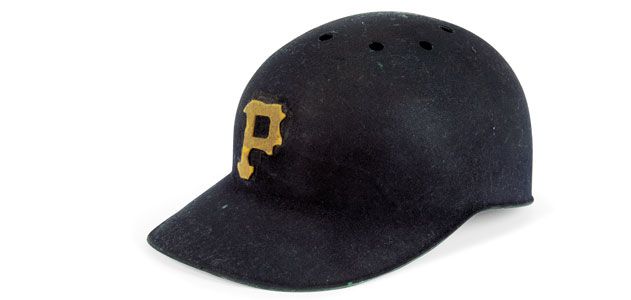September 20, 2017
Roberto Clemente: Baseball Legend and Latino Hero

Roberto Clemente was born and raised in the small town of Carolina, Puerto Rico in the early 1930’s. He was the youngest of seven children.1 From a young age he excelled at baseball and at the track event Javelin. At age eighteen, he tried out for the Brooklyn Dodgers. Roberto made the team with ease in 1952, but this is where his trials began. The Dodgers had five African-American players on the team already, including the famous Jackie Robinson. The owners saw no need for another “colored” player on the team.2

After his contract with the Dodgers’ minor league team in Montreal expired, the young Pittsburgh Pirates organization picked up Clemente in order to rebuild their team. But the Pirates didn’t give him a lot of playing time either, so he decided to return to Puerto Rico.3 But in 1956, after dominating back in his home town, Roberto finally caught his break with the Pirates. He returned to the United States, and he began to rise in fame rapidly, gaining success in the League. In his first season he finished with a batting average of .255. This success didn’t smash the curveball that was thrown his way because of his race. On several occasions, his teammates called him a “nigger.” It was also common for Clemente to stay in separate hotels from the white players on the team, due to segregation laws. Young Clemente was not even treated as an equal in the sport that he had been working so hard for years to adapt to.4 Whether it was the law, or people’s racial prejudices, Clemente continued to remain the outsider.
The Pirates eventually won the World Series in 1960, and Roberto Clemente finished that season with the stellar batting average of .310. As Clemente began to rise in fame, and people began to realize his potential for greatness, he began to receive death threats in the mail. One of the letters read “Did you ever get shot before?”5 In fear for his family’s safety, Clemente moved them home to Puerto Rico in order to protect them from such bigoted Americans of the 1960’s. After moving his family back to Puerto Rico, Clemente told the media, “I don’t want to be put down because I’m Puerto Rican. I don’t stand for disliking someone because of their color. If this is the case, I don’t want to be living. I am a double nigger….. for my skin and my heritage.”6
After Clemente moved his family back to Puerto Rico, and bounced back from the serial experience of death threats, and he became the League’s MVP in 1966.7 Clemente refused to let others keep him down because of the color of his skin. Clemente was not only an inspiration to people on the field, but was so off the field as well. In his spare time he would visit Puerto Rico in order to spend time with his family. But he also gave back to the struggling community he grew up in by helping out in the local clinic in Carolina. He also opened youth baseball programs for kids in Puerto Rico.8 Roberto helped raise over $150,000 for his home town. Clemente’s love for others, and actions in order to help his people and the community, was recognized by people all over the United States. He was becoming one of the most well-known athletes not only for his incredible playing abilities, but for his devotion to his personal humanitarian aspirations.
Then suddenly, on New Years Eve in 1972, while flying to Nicaragua to drop supplies off after a tragic earthquake, Roberto Clemente’s plane crashed. There were no survivors and Roberto Clemente’s body was never found. The plane was allegedly 1,900 kilograms over the weight it could carry.9

Roberto Clemente finished his career with over 3,000 hits, 4 World Series titles, 12 Golden Gloves, a two-time League MVP, and was inducted into the Hall of Fame in 1973.10 Roberto Clemente is remembered in Major League Baseball for so much more than these incredible stats. To this day, the MLB gives the Humanitarian Award to baseball players who best exemplify service to their team, community, and families.11 Clemente will forever be recognized for his love for others. And he fought for a sport he loved. There is much diversity in the MLB today, whether it is Yu Darvish from Japan, Didi Gregorius from the Netherlands, Arolodis Chapman from Cuba, or Carlos Correa from Puerto Rico. Clemente is a major reason for this diversity. He received death threats and experienced discrimination because of his color. But, most importantly, after all these trials, Clemente still managed to give back to his community and love others, which is why he’s an inspiration to Latinos and to people everywhere.
- Alan West, Roberto Clemente: Baseball Legend (Brookfield, Conn: Lerner Publishing Group, 1993), 6. ↵
- Salem Press Biographical Encyclopedia, January 2017, s.v. “Roberto Clemente,” by Lynn C. Kronzek. ↵
- Alan West, Roberto Clemente: Baseball Legend (Brookfield, Conn: Lerner Publishing Group, 1993), 10-12. ↵
- Alan West, Roberto Clemente: Baseball Legend (Brookfield, Conn: Lerner Publishing Group, 1993), 10-12. ↵
- Roberto Clemente. n.p.: (Washington, D.C.): Federal Bureau of Investigation, 2003. ↵
- Alan West, Roberto Clemente: Baseball Legend, (Brookfield, Conn: Lerner Publishing Group, 1993), 13. ↵
- Salem Press Biographical Encyclopedia, January 2017, s.v. “Roberto Clemente,” by Lynn C. Kronzek. ↵
- Alan West, Roberto Clemente: Baseball Legend (Brookfield, Conn: Lerner Publishing Group, 1993) 19-25. ↵
- Madeleine White, “Baseball’s Roberto Clemente dies in a plane crash,” Globe & Mail , 2015, A2. ↵
- Salem Press Biographical Encyclopedia, January 2017, s.v. “Roberto Clemente,” by Lynn C. Kronzek. ↵
- Wes Lukowsky, “Clemente: The True Legacy of an Undying Hero,” Booklist 110, no. 1 (2013): 30. ↵
Tags from the story
Roberto Clemente